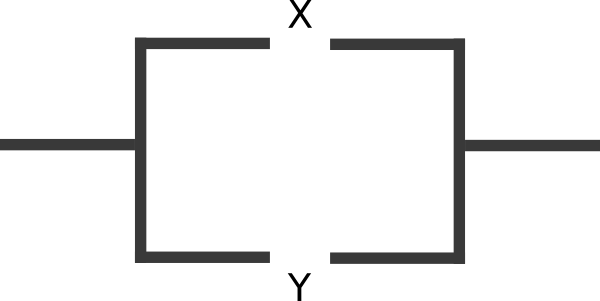Claude E Shannon


Claude Shannon built the algebraic model of circuitry and the digital model of communication; without Shannon, there is no modern computer or internet.
Algebraic model of circuitry
Charge is a real number. A proton exhibits charge of 1e. An electron exhibits charge of -1e. Charge induces electric force: electrons force apart, protons force apart, and an electron and proton force together.
A basic example: a sequence of an electron, a copper atom, and a proton. The outermost electron of the copper atom is the valence electron. Below, the electron is blue and the valence electron is yellow. The relevant electric forces: the valence electron and proton force together, the valence electron and electron force apart, and the electron and protons in the copper atom's nucleus force together.

An electron exhibits less mass than a proton. Therefore, the valence electron moves toward the proton, and the electron replaces it in the copper atom. This is electric current: the movement of electrons due to electric force.

An electric circuit is an expansion of the above sequence, more numerous in electrons, copper atoms, and protons.

The movement of electrons in the above circuit, depicted at three successive moments in time:

In practice, the electrons are a battery's negative terminal, the copper is a wire, and the protons are a battery's postive terminal.

A circuit may be open or closed. A closed circuit allows electrons to move across the copper. An open circuit prevents electrons from moving across the copper. Below, X is a hindrance in the circuit, representing if the circuit is open or closed: 1 if open, 0 if closed. Note that this is opposite the modern interpretation of 1 and 0 in circuitry.

A circuit may include multiple hindrances:

Above is a series circuit: one copper path exists for electrons to move. Two hindrances connected in series is represented as addition. Therefore, the above is X+Y. Shannon states three postulates for addition:
0+0=0. If both hindrances are closed, the circuit is closed.
1+1=1. If both hindrances are open, the circuit is open.
1+0=0+1=1. If one hindrance is open, the circuit is open.
A parallel circuit includes multiple paths for electrons to move:

Two hindrances connected in parallel is represented as multiplication. Therefore, the above is X*Y. Shannon states three postulates for multiplication:
0*0=0. If both hindrances are closed, the circuit is closed.
1*1=1. If both hindrances are open, the circuit is open.
1*0=0*1=0. If one hindrance is closed, the circuit is closed.
An example: a basic lock. If the user closes X and Y simultaneously, the lock is released. If the user closes X and Z simultaneously, the alarm is triggered. The circuit:

The algebraic expression is (X+Y)(X+Z). Expand the expression:
XX+XZ+XY+YZ
XX=X, therefore:
X+XZ+XY+YZ
X+XZ+XY=X, therefore:
X+YZ. The circuit:

The circuit's hindrances are minimized; this is the utility of Shannon's model. More complex examples and the set of algebraic manipulations can be found in Shannon's paper: A Symbolic Analysis of Relay and Switching Circuits.